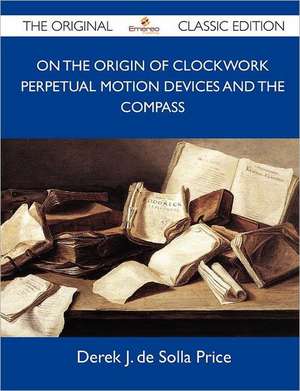On the Origin of Clockwork Perpetual Motion Devices and the Compass - The Original Classic Edition
Autor Derek J. De Solla Priceen Limba Engleză Paperback – 14 iun 2012
This is a new and freshly published edition of this culturally important work, which is now, at last, again available to you.
Enjoy this classic work today. These selected paragraphs distill the contents and give you a quick look inside:
For the mechanical clock, perhaps the greatest hindrance has been its treatment within a self-contained history of time measurement in which sundials, water-clocks and similar devices assume the natural role of ancestors to the weight-driven escapement clock in the early 14th century.1 This view must presume that a generally sophisticated knowledge of gearing antedates the invention of the clock and extends back to the Classical period of Hero and Vitruvius and such authors well-known for their mechanical ingenuities.
...The very full historical and technical description in this text enabled us to establish a glossary and basic understanding of the mechanism that later enabled us to interpret a whole series of similar, though less extensive texts, giving a history of prior development of such devices going back to the introduction of this type of escapement by I-Hsing and Liang Ling-tsan, in A.D. 725, and to what seems to be the original of all these Chinese astronomical machines, that built by Chang Hêng ca.
...But this newer kind of globe, he said, on which were delineated the motions of the sun and moon and of those five stars which are called wanderers, or, as we might say, rovers [i. e., the five planets], contained more than could be shown on the solid globe, and the invention of Archimedes deserved special admiration because he had thought out a way to represent accurately by a single device for turning the globe, those various and divergent movements with their different rates of speed.
...In any case, the material supplied by the works ascribed to Archimedes, Hero, and Vitruvius, and the more certain evidence of the anaphoric clocks is sufficient to show that there was a strong classical tradition of such machines, a tradition that inspired, even if it did not directly influence, later developments in Islam and Europe on the one side, and, just possibly, China on the other.
...A self-revolving instrument [or swayanvaha yantra]: Make a wheel of light wood and in its circumference put hollow spokes all having bores of the same diameter, and let them be placed at equal distances from each other; and let them also be placed at an angle verging somewhat from the perpendicular: then half fill these hollow spokes with mercury; the wheel thus filled will, when placed on an axis supported by two posts, revolve of itself.
Preț: 71.68 lei
Nou
Puncte Express: 108
Preț estimativ în valută:
13.72€ • 14.91$ • 11.53£
13.72€ • 14.91$ • 11.53£
Carte tipărită la comandă
Livrare economică 16-22 aprilie
Preluare comenzi: 021 569.72.76
Specificații
ISBN-13: 9781486152407
ISBN-10: 1486152406
Pagini: 24
Dimensiuni: 189 x 246 x 1 mm
Greutate: 0.07 kg
Editura: Emereo Classics
ISBN-10: 1486152406
Pagini: 24
Dimensiuni: 189 x 246 x 1 mm
Greutate: 0.07 kg
Editura: Emereo Classics






